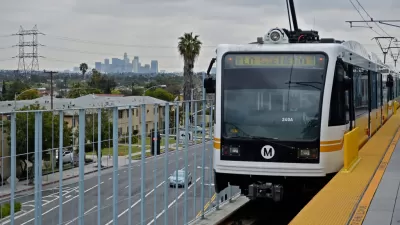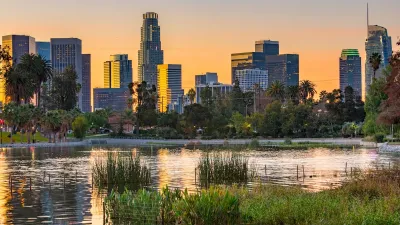If Los Angeles residents approve the $120 billion sales tax measure in November, focusing on walkable communities and offering fast, frequent transit service will be critical to its success.

"There is no place in the country better positioned to use transit to its advantage than Los Angeles County," opines Steven Higashide, a senior program analyst for TransitCenter, a New York foundation dedicated to improving urban mobility.
And should voters pass a county sales tax measure on November 8 by over two-thirds, $120 billion will be available to build-up public transit. But it's not just a matter of laying more track, constructing new stations, planning new bus lines and operating trains and running buses.
[I]f the goal of Los Angeles’ transit investments is to have buses and trains shape the region in the 21st century the way the automobile did in the 20th — building transit is not enough. For proof, look no further than Metro’s overall ridership, which so far is 5.5% lower in 2016 than in 2015 despite two new rail extensions.
Higashide repeats a theme made by Kevin Cashman, a Truthout researcher, in his recent critique of new transportation technologies, particularly in their ability to serve lower income populations.
For all the talk about using Uber, Lyft and bike share to bridge the 'first mile, last mile' gap to transit, it’s far more important to put bus and rail stops in places where people don’t have to walk a mile or more to reach them.
Transit needs to be in the middle of the action, not sent to the edge of town. New housing, offices, and retail should be concentrated near it.
Higashide points to a new TransitCenter report, "'Who’s On Board' [PDF], that gathered data from three focus groups and a survey of 3,000 people in 17 metro areas in the United States, [that] sheds light on how it can be done."
"It builds on the findings from TransitCenter’s first Who’s On Board report released in 2014 [and posted here] — the largest-ever attitudinal survey of transit riders—which showed that Americans from coast to coast think about and use public transit in remarkably similar and often unexpected ways," states the press release.
Higashide emphasizes the need to "reform land-use regulations to nurture inviting walking environments."
As another Times opinion piece noted, Los Angeles is a major global city whose zoning codes, parking requirements and development politics treat it like an enormous suburb. For transit to succeed, those laws and attitudes must change.
And the top priority for new transit expansion should be busy destinations that are already walkable. By making transit frequent and fast and building walkable neighborhoods around transit, Los Angeles can make it a practical choice for many more people.
FULL STORY: Opinion: Without more walkable cities, building new transit won't reverse Metro's ridership decline

Study: Maui’s Plan to Convert Vacation Rentals to Long-Term Housing Could Cause Nearly $1 Billion Economic Loss
The plan would reduce visitor accommodation by 25,% resulting in 1,900 jobs lost.

North Texas Transit Leaders Tout Benefits of TOD for Growing Region
At a summit focused on transit-oriented development, policymakers discussed how North Texas’ expanded light rail system can serve as a tool for economic growth.

Why Should We Subsidize Public Transportation?
Many public transit agencies face financial stress due to rising costs, declining fare revenue, and declining subsidies. Transit advocates must provide a strong business case for increasing public transit funding.

How to Make US Trains Faster
Changes to boarding platforms and a switch to electric trains could improve U.S. passenger rail service without the added cost of high-speed rail.

Columbia’s Revitalized ‘Loop’ Is a Hub for Local Entrepreneurs
A focus on small businesses is helping a commercial corridor in Columbia, Missouri thrive.

Invasive Insect Threatens Minnesota’s Ash Forests
The Emerald Ash Borer is a rapidly spreading invasive pest threatening Minnesota’s ash trees, and homeowners are encouraged to plant diverse replacement species, avoid moving ash firewood, and monitor for signs of infestation.
Urban Design for Planners 1: Software Tools
This six-course series explores essential urban design concepts using open source software and equips planners with the tools they need to participate fully in the urban design process.
Planning for Universal Design
Learn the tools for implementing Universal Design in planning regulations.
City of Santa Clarita
Ascent Environmental
Institute for Housing and Urban Development Studies (IHS)
City of Grandview
Harvard GSD Executive Education
Toledo-Lucas County Plan Commissions
Salt Lake City
NYU Wagner Graduate School of Public Service





























